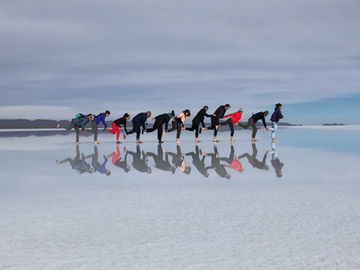Salar de Uyuni (Salt Flats), Bolivia
- Cheryl
- Aug 17, 2019
- 3 min read
Updated: Aug 28, 2019
Our oldest daughter, Shannon, is skeptical as she scans tour agency reviews. “This one is a no-go,” she says. “The driver got drunk, drove into a mud flat and they almost died of hypothermia.” We're in the small town of Uyuni, gateway to the Salar de Uyuni (salt flats) and Eduardo Avaroa Andean Fauna National Reserve, but choosing a tour of the flats is proving challenging. Agencies aren’t subject to any coherent government regulations and safety concerns are often cast aside in the rush to make a buck. Horror stories of tours gone bad abound. After much debate, we choose a three-day, two-night tour with Salty Desert Aventours. Fingers crossed!

At nine the next morning we meet our travel mates — a young German couple and English-speaking guide who will ride with us in a somewhat cramped 4x4 Toyota of a certain vintage. The other vehicle has six tourists and a driver. At 11,000-square-kilometres, the Salar is the world's largest salt flat. At an altitude of 3658 metres, it’s also one of the world’s highest. There are no signs, no roads, no landmarks, just a vast expanse of crunchy whiteness that only an experienced driver can navigate.

We reach the flats at high noon and explore the natural wonders before our guide, Oscar, leads us to the perfect locations for photos — first a flat expanse where we can play with perspective, then a spot where a thin layer of water pulls earth and sky into one. Noel puts on flip flops on to protect his feet from the sharp edges of the salt, but I try out my high tech water proof socks.







Six hours later, tired, our clothes and feet covered in patches of salt from our photo session, we pull up to our hotel. Unbelievably, it’s made of salt! Entering we see that even the chairs and tables are made from salt. The floor is covered in loose salt, as well. I'll never think of salt as just a humble condiment again!


The next morning, vehicles loaded, we take our turn sitting in the cramped back seat. We settle in, knees sideways, thankful that we're not any taller. Leaving the salt flats behind us, we enter Eduardo Avaroa National Reserve of Andean Fauna. Covering over 7000 square kilometres, this plateau desert on the high plains of the Andes lies between 4200m and 5000 above sea level. At this altitude, some people on our tour begin suffering from altitude sickness. But luckily, after spending the previous weeks slowing exposing ourselves to higher and higher altitudes, we escape this malady.

Our first stop in the barren, yet bizarrely beautiful landscape is the Stone Tree, one of many striking sand stone formations in the reserve created by strong winds and blowing sands over millions of year.

Driving on, the incredible landscape flies by like a series of surreal paintings. Stopping at the Salvador Dali Desert I feel like I've wandered right into a Dali painting.


The climax of the day is Sol de Manana, (Morning Sun), a geothermal field. Pools of boiling mud send streams of steam into the air converting the area into a foggy other world, people appearing and disappearing in the steam like apparitions.


It is almost dark when we arrive at our hotel close to Aguas Termales de Polques, (hot springs) Although the thought of soaking in thirty- seven degree hot springs was inviting, I couldn't contemplate walking back soaking wet after the night air dipped below freezing.

Although it's summer in Bolivia, the high altitude means temperatures plummet at night. That, combined with basic hotels sans heating, left me extra thankful for the sleeping bag I’d rented before leaving Uyuni.
On day three we say goodbye to some of our travel companions, who head to the Chilean border after lunch, a meal of pasta, quinoa, roast meats and fresh fruit. But despite our hunger and the feast before us, we’re too mesmerized by the panoramic view of Laguna Colorada to eat much. Pink flamingos dot the lake in stark contrast to the crimson coloured water. The 6000 hectare, one-metre-deep salt lake gets its colour from rare algae and minerals. It’s also home to three of the world's six species of flamingos, including the rare James' flamingo. Our guide explains that the birds stand on one foot at time because they lose body heat to the water through their legs and feet.


After several more hours of driving, we arrive back in Uyuni bone tired but happy. The cold nights, basic accommodation and long days of driving did not in any way dampen our spirits. Rather, it added to the adventure. Our guide was exactly what a guide should be — knowledgeable, informative, interesting, helpful, and friendly. Our driver was competent, and above all drove safely. Check another one off our bucket list!

Comments